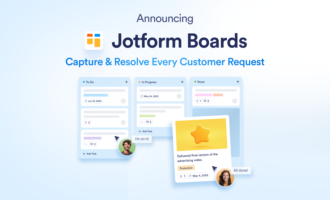One study after another has proven that collaboration in the workplace is critical — businesses that get it right often outperform competitors and boast a more engaged, more motivated workforce.
Similarly, those organizations, both large and small, that not only acknowledge the value of collaboration but actually invest in it — through team-building exercises for work and the right kind of leadership — can more quickly build a collaborative culture and achieve the outcomes that better teamwork fosters.
For small businesses in particular, each person on the team needs to work well with others. And improving how your team works together is now de rigeur.
Team-building activities for work are designed to help improve rapport among your staff and create a workplace where each member feels appreciated, making growth and success easier for your business to achieve.
Collaborate on Tasks with Jotform Boards
The goals of successful collaboration include
- Working through a problem together to gather insight and progress
- Increasing communication between team members
- Finding out the value of your team’s individual and group resources
Pro Tip
Sign up for a free Jotform account to create powerful online forms in minutes — with no coding required.
3 simple collaboration activities and team-building exercises for work
These exercises are effective and easy to implement. You can adapt all of them for virtual work environments.
For instance, you can substitute videoconferencing — using Zoom, Skype, Google Meet, GoToMeeting, etc. — for in-person interaction (like separate calls for small groups or pairs). Instead of a white board, you can use social technology tools — such as Google Docs, Slack, etc. — for collective documentation of the activity or exercise so each person can see a live, changing document.
1. Collaborative problem-solving teamwork exercise
Size: 4+ people
Time: Around an hour
Exercise: With a whiteboard and markers (or virtual equivalent), gather members and choose a problem currently facing your organization.
- Define the problem. What is undesirable about it, and what obstacles does it create for your team?
- Brainstorm solutions. Allow a free flow of ideas at this stage. Reserve any judgement or criticism until the next stage.
- Analyze each idea. Attach strengths and weaknesses to ideas by encouraging opinions from each member of the group, if possible. Order the options according to the most advantages and fewest negatives, creating a best-to-worst list. From this list, go over the best options thoroughly. What does this solution look like in different time frames, with unexpected changes, etc.? Choose the most durable and supported solution.
- Implement the solution by establishing a clear, step-by-step plan. Put clear roles and time frames in place for team members to follow.
Collaboration objective: This team-building exercise will develop problem-solving skills and rapport within your team. The ideal scenario is to arrive at a consensus where each team member is heard in at least one (if not each) aspect of the exercise. Provide some facilitation to encourage less forthright members to comment and allow more assertive members to listen; this will create balance for the exercise.
Source: developed from the NCES report on collaborative problem solving
2. Skills success exercise
Size: 2 or more pairs
Time: 10–15 minutes
Exercise: Separate team members into pairs and ask them to discuss one success they have had in a predetermined time frame (year, quarter, last week). This can be on a specific topic of your choosing (such as conversations with clients, organizing their time, or insights they’ve gained). Choosing pairs with different roles on your team can create more opportunities for learning.
- Have one employee speak for about three minutes about a success they’ve had.
- When this employee has finished, have the second member of the pair reflect back what they heard clearly.
- Repeat the first two steps for the second employee.
- Bring everyone together and have each person explain the success of their teammate.
- Hold a discussion with all pairs about what common themes and issues, if any, came up around clearly sharing and understanding successes.
Collaboration objective: This team-building exercise will help facilitate clear and effective communication between team members. It will also highlight and share successes within your team.
Source: developed from UMA Research
3. Team network activity
Size: 6 or more
Time: 20–30 minutes
Exercise: Break your team into small groups of roughly equal size. Each group should determine the people who have been the most supportive. The aim is to get a better sense of who helps move your business or organization along.
- Have each group member answer the following questions:
- Who do you communicate with the most about completing tasks?
- Who has helped you most recently with a challenging task?
- Who on your team haven’t you acknowledged recently?
- What’s one thing you’ve done to help others?
- Ask the small groups if there are people or types of help that are most useful to them.
- Come back to the full group and have each small group report on what they discovered about common helpful people and practices.
- Talk about any commonalities in people and practices that participants noticed in what they shared.
- Decide on ways to change less helpful roles or practices.
Collaboration objective: This team-building activity finds and highlights the unsung members of your team. You can ask the small groups to allocate roles to different team members (such as writer of group notes, person who reports to the full group, etc.). This can highlight or build skill sets (like public speaking and leadership skills) as an added benefit.
Source: developed from McKinsey Quarterly research
Enhancing team collaboration and efficiency with Jotform Boards
Jotform Boards helps teams collaborate and manage projects more efficiently. Team members can easily process incoming data through forms and track each stage of the project. Tasks can be automatically created from forms, saving time and accelerating workflows. Additionally, comments, documents, and other updates related to each task ensure that all team members stay on the same page, enhancing collaboration.
In terms of team building and cooperation, Jotform Boards fosters effective communication among team members. By having everyone on the same platform, the progress of tasks can be monitored and managed in a coordinated manner. This transparency and collaborative culture not only strengthens team spirit but also improves productivity. In this way, teams not only complete tasks but also build stronger relationships with each other.
The value of collaboration
Collaboration activities and team-building exercises are essential if you want to discover and leverage the strengths and unique perspectives of your team. Regularly incorporating them will help you gain valuable insight into what makes your team work as well as how to adapt to the challenges your team faces every day.






Send Comment: